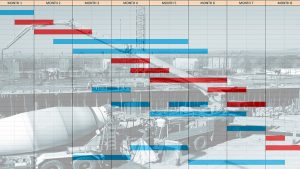The federal government’s 2017 budget wasn’t filled with any surprises, but rather assurances it is still committed to infrastructure funding and boosting Canada’s economy one way or another, stated several national construction industry stakeholders.
"Not a heck of a lot new in this budget from an infrastructure point of view," Canadian Construction Association (CCA) president Michael Atkinson pointed out while attending the CCA’s 99th annual conference in Mexico. The event happened to correspond with Finance Minister Bill Morneau’s budget speech March 22. "Frankly the economic statement last fall was more of a budget for us in terms of infrastructure."
Atkinson stated the government’s continued commitment to spend a total of $180 billion for projects rolling out through to 2027-28 was encouraging but light on the details.
John Gamble, president and CEO of the Association of Consulting Engineering Companies – Canada, echoed his comments.
"The direction is right but we’ve been hoping for a clearer road map to that destination," he said of the funding, which also included an additional $81.2 billion over 11 years to support public transit, green infrastructure, social infrastructure and transportation that supports trade.
However, when it comes to infrastructure dollars, affordable housing was the main newsmaker in Budget 2017, which was coined Building a Strong Middle Class. As part of a new National Housing Strategy, the federal government will invest more than $11.2 billion over 10 years towards building, renewing and repairing Canada’s stock of affordable housing. Included in this is $225 million to improve housing conditions for indigenous people not living on-reserve.
Budget 2017 also proposes to invest $300 million over the next 11 years to support northern housing by helping territorial governments offset the higher cost of construction in the north, the budget reads. Approximately $24 million will be provided to the Yukon, $36 million to the Northwest Territories and $240 million to Nunavut.
"Many of our members do things like community housing and those types of projects," said Gamble, adding the funding was welcome news. "But I think there needs to be some priority to those projects that actually generate revenue, generate economic activity because that’s what gives you the capacity to be able to fund these types of projects."
The Canada Infrastructure Bank may be one method to help fund those projects that generate revenue, Gamble explained. According to the budget, the bank will be responsible for investing at least $35 billion over 11 years, using loans, loan guarantees and equity investments.
"These investments will be made strategically, with a focus on large, transformative projects such as regional transit plans, transportation networks and electricity grid interconnections," it reads.
What’s more, the government announced a timeline for the bank’s creation, stating it will "begin a process to identify the bank’s chief executive officer and chairperson of the board of directors, with the goal of having the Canada Infrastructure Bank operational in late 2017."
Both Atkinson and Gamble stated it was a step in the right direction to get the infrastructure bank moving forward, but added it has to be done right.
Paul de Jong, president of the Progressive Contractors Association of Canada (PCA), said in a statement he too found this news was encouraging.
"PCA welcomes the details that were provided today on the Canada Infrastructure Bank," he said. "We view the acceleration of infrastructure spending as critical to growing our economy."
Tied closely to this is the National Trade Corridor Fund, which according to the budget is geared towards addressing "urgent capacity constraints and freight bottlenecks at major ports of entry, and to better connect the rail and highway infrastructure that delivers economic growth across Canada."
Budget 2017 states it will provide $2 billion over 11 years to support the fund’s activities. At least an additional $5 billion will be provided through the Canada Infrastructure Bank to address trade and transportation priorities. Specifically, the budget notes the investments will target marine ports such as Vancouver and Montreal as well as the busiest rail and highway corridors around the Greater Toronto Area and other urban centres across the country.
"The National Trade Corridors Fund, along with the infrastructure bank, is one of the initiatives from the fall financial statement that we’re quite glad to see enshrined in this budget," Gamble added.
"This is precisely the kind of infrastructure that grows the economy. It’s particularly critical now in the United Sates where NAFTA (the North American Free Trade Agreement) is up for renegotiation, we’re seeing a regime that very interested in deregulation. We need every opportunity to be competitive. This is the type of infrastructure that speaks directly to our competitiveness, both with the United States and around the world."











Recent Comments
comments for this post are closed